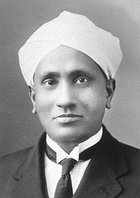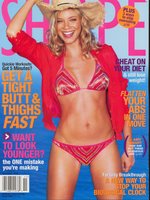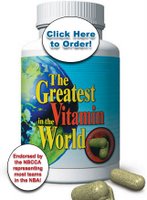Simple
Steps to Preventing Diabetes
If type 2 diabetes was an infectious disease, passed from one person
to another, public health officials would say we're in the midst of an
epidemic. This difficult disease, once called adult-onset diabetes, is
striking an ever-growing number of adults. Even more alarming, it's now
beginning to show up in teenagers and children.
More than 18 million Americans have diabetes; about 5 million don't know
they have the disease.(1) If the spread of type
2 diabetes continues at its present rate, the number of people affected
in the United States will increase from about 14 million in 1995 to 22
million in 2025. Worldwide, the number of adults with diabetes will rise
from 135 million in 1995 to 300 million in the year 2025.(2)
The problems behind the numbers are even more alarming. Diabetes is the
leading cause of blindness and kidney failure among adults. It causes
mild to severe nerve damage that, coupled with diabetes-related circulation
problems, often leads to the loss of a leg or foot. Diabetes significantly
increases the risk of heart disease. And it's the sixth leading cause
of death in the U.S., directly causing almost 60,000 deaths each year
and contributing to thousands more.(3)
The good news is that type 2 diabetes is largely preventable. About 9
cases in 10 could be avoided by taking several simple steps: keeping
weight under control, exercising more, eating a healthy diet, and
not smoking.
What Is Type 2 Diabetes?
Our cells depend on a single simple sugar, glucose, for most of their
energy needs. That's why the body has intricate mechanisms in place to
make sure glucose levels in the bloodstream don't go too low or soar too
high.
When you eat, most digestible carbohydrates
are converted into glucose and rapidly absorbed into the bloodstream.
Any rise in blood sugar signals the pancreas to make and release insulin.
This hormone instructs cells to sponge up glucose. Without it, glucose
floats around the bloodstream, unable to slip inside the cells that need
it.
Diabetes occurs when the body can't make enough insulin or can't properly
use the insulin it makes.
One form of diabetes occurs when the immune system attacks and permanently
disables the insulin-making cells in the pancreas. This is type 1 diabetes,
once called juvenile-onset or insulin-dependent diabetes. It affects about
one million Americans.
The other form tends to creep up on people, taking years to develop into
full-blown diabetes. It begins when muscle and other cells stop responding
to insulin's open-up-for-glucose signal. The body responds by making more
and more insulin, essentially trying to ram blood sugar into cells. Eventually,
the insulin-making cells get exhausted and begin to fail. This is type
2 diabetes.
In addition to the 18 million adults with diabetes, another 41 million
have "pre-diabetes." (1) This early
warning sign is characterized by high blood sugar levels on a glucose
tolerance test or a fasting glucose test. Whether pre-diabetes expands
into full-blown type 2 diabetes is largely up to the individual-making
changes in weight, exercise, and diet can not only prevent pre-diabetes
from becoming diabetes, but can also return blood glucose levels to the
normal range.
Type 2 Diabetes Can Be Prevented
Although the genes you inherit may influence the development of type
2 diabetes, they take a back seat to behavioral and lifestyle factors.
Data from the Nurses' Health Study suggest that 90% of type 2 diabetes
in women can be attributed to five such factors: excess weight, lack of
exercise, a less-than-healthy diet, smoking, and abstaining from alcohol.(4)
Among 85,000 married female nurses, 3,300 developed type 2 diabetes over
a 16-year period. Women in the low-risk group were 90% less likely to
have developed diabetes than the rest of the women. Low-risk meant a healthy
weight (body-mass index [BMI] less than 25), a healthy diet, 30 minutes
or more of exercise daily, no smoking, and having about three alcoholic
drinks per week.
Similar factors are at work in men. Data from the Health Professionals
Follow-up Study indicate that a "western" diet combined with
lack of physical activity and excess weight dramatically increases the
risk of type 2 diabetes in men.(5)
Information from several clinical trials strongly support the idea that
type 2 diabetes is preventable. The Diabetes Prevention Program examined
the effect of weight loss and increased exercise on the development of
type 2 diabetes among men and women with high blood sugar readings that
hadn't yet crossed the line to diabetes. In the group assigned to weight
loss and exercise, there were 58% fewer cases of diabetes after almost
three years than in the group assigned to usual care. (6)
Similar results were seen in a Finnish study of weight loss, exercise,
and dietary change.(7)
Simple Steps
Making a few changes can dramatically lower the chances of developing
type 2 diabetes. The same changes can also lower the chances of developing
heart disease and some cancers.
Control
your weight. Excess weight is the single most important
cause of type 2 diabetes. Being overweight
increases the chances of developing type 2 diabetes seven-fold. Being
obese makes you 20 to 40 times more likely to develop diabetes than someone
with a healthy weight. (4)
Losing weight can help if your weight is above the healthy-weight range.
Losing 7-10% of your current weight can cut in half your chances of developing
type 2 diabetes.
Get
moving. Inactivity promotes type 2 diabetes. Every
two hours you spend watching TV instead of pursuing something more active
increases the changes of developing diabetes by 14%.(8)
Working your muscles more often and making them work harder improves their
ability to use insulin and absorb glucose. This puts less stress on your
insulin-making cells.
Long bouts of hot, sweaty exercise aren't necessary to reap this benefit.
Findings from the Nurses' Health Study and Health Professionals Follow-up
Study suggest that walking briskly for a half hour every day reduces the
risk of developing type 2 diabetes by 30%.(9, 10)
This amount of exercise has a variety of other benefits as well. And
even greater cardiovascular and other benefits can be attained by more,
and more intense, exercise.
Tune-up your diet.
Two dietary changes can have a big impact on the risk of type 2 diabetes.
- Choose
whole grains and whole-grain products over highly processed carbohydrates.
White bread, white rice, mashed potatoes, donuts, bagels, and many breakfast
cereals have what's called a high
glycemic index. That means they cause sustained spikes in blood
sugar and insulin levels. Carbohydrates that aren't as easily digested
cause lower, slower increases in blood sugar and insulin. As a result,
they stress the body's insulin-making machinery less, and so help prevent
type 2 diabetes.(11) Such foods have a low
glycemic index. Examples include whole wheat, brown rice, other whole
grains, most beans and nuts, and whole grain breakfast cereals.
- Choose
good fats instead of bad fats. The types of fats
in your diet can also affect the development of diabetes. Good fats,
such as the polyunsaturated fats found in tuna, salmon, liquid vegetable
oils, and many nuts, can help ward off type 2 diabetes.(12)
Trans fats do just the opposite. These bad fats are found in
many margarines, packaged baked goods, fried foods in most fast-food
restaurants, and any product that lists "partially hydrogenated
vegetable oil" on the label. If you already have diabetes, eating
fish can help protect you against a heart attack or dying from heart
disease.(13)
If you smoke, try to
quit. Add type 2 diabetes to the long list of health problems
linked with smoking. Smokers are 50% to 90% more likely to develop diabetes
than nonsmokers.(14, 15)
Alcohol
now and then may help. A growing body of evidence links
moderate alcohol consumption with reduced risks of heart disease. The
same may be true for type 2 diabetes. Moderate amounts of alcohol-a drink
a day for men, a drink every other day for women-increases the efficiency
of insulin at getting glucose inside cells. And some studies indicate
that moderate alcohol consumption decreases the risk of type 2 diabetes.
(4, 14) If you already drink alcohol, the key
is to keep your consumption in the moderate range. If you don't drink
alcohol, there's no need to start-you can get the same benefits by losing
weight, exercising more, and changing your eating patterns.
The bottom line
They key to preventing type 2 diabetes can be boiled down to five words:
Stay lean and stay active.
References
1. Centers for Disease Control and Prevention. National diabetes fact
sheet. U.S. Department of Health and Human Services, Centers for Disease
Control and Prevention: Atlanta, GA, 2004. http://www.cdc.gov/diabetes/pubs/pdf/ndfs_2003.pdf
accessed on 29 September 2004.
2. King H, Aubert RE, Herman WH. Global burden of diabetes, 1995-2025:
prevalence, numerical estimates, and projections. Diabetes
Care 1998; 21:1414-31.
3. Kochanek KD, Smith BL. Deaths: preliminary data for 2002. National
Center for Health Statistics: Hyattsville, Maryland, 2004. National vital
statistics reports; vol. 52, no. 13. http://www.cdc.gov/nchs/data/nvsr/nvsr52/nvsr52_13.pdf
accessed on 29 September 2004.
4. Hu FB, Manson JE, Stampfer MJ, et al. Diet, lifestyle, and the risk
of type 2 diabetes mellitus in women. N
Engl J Med 2001; 345:790-7.
5. van Dam RM, Rimm EB, Willett WC, Stampfer MJ, Hu FB. Dietary patterns
and risk for type 2 diabetes mellitus in U.S. men. Ann
Intern Med 2002; 136:201-9.
6. Knowler WC, Barrett-Connor E, Fowler SE, et al. Reduction in the incidence
of type 2 diabetes with lifestyle intervention or metformin. N
Engl J Med 2002; 346:393-403.
7. Tuomilehto J, Lindstrom J, Eriksson JG, et al. Prevention of type
2 diabetes mellitus by changes in lifestyle among subjects with impaired
glucose tolerance. N
Engl J Med 2001; 344:1343-50.
8. Hu FB, Li TY, Colditz GA, Willett WC, Manson JE. Television watching
and other sedentary behaviors in relation to risk of obesity and type
2 diabetes mellitus in women. JAMA
2003; 289:1785-91.
9. Tanasescu M, Leitzmann MF, Rimm EB, Hu FB. Physical activity in relation
to cardiovascular disease and total mortality among men with type 2 diabetes.
Circulation
2003.
10. Hu FB, Sigal RJ, Rich-Edwards JW, et al. Walking compared with vigorous
physical activity and risk of type 2 diabetes in women: a prospective
study. JAMA
1999; 282:1433-9.
11. Ludwig DS. The glycemic index: physiological mechanisms relating
to obesity, diabetes, and cardiovascular disease. JAMA
2002; 287:2414-23.
12. Salmeron J, Hu FB, Manson JE, Stampfer MJ, Colditz GA, Rimm EB, Willett
WC. Dietary fat intake and risk of type 2 diabetes in women. Am
J Clin Nutr 2001; 73(6):1019-26.
13. Hu FB, Cho E, Rexrode KM, Albert CM, Manson JE. Fish and long-chain
omega-3 fatty acid intake and risk of coronary heart disease and total
mortality in diabetic women. Circulation
2003; 107:1852-7.
14. Rimm EB, Chan J, Stampfer MJ, Colditz GA, Willett WC. Prospective
study of cigarette smoking, alcohol use, and the risk of diabetes in men.
BMJ
1995; 310:555-9.
15. Rimm EB, Manson JE, Stampfer MJ, et al. Cigarette smoking and the
risk of diabetes in women.
Am J Public Health 1993; 83:211-4.
16. Ludwig DS, Ebbeling CB. Type 2 diabetes mellitus in children: primary
care and public health considerations. JAMA
2001; 286:1427-30.
The aim of the Harvard School of Public Health Nutrition
Source is to provide timely information on diet and nutrition for clinicians,
allied health professionals, and the public. The contents of this Web site
are not intended to offer personal medical advice, which should be obtained
from a health-care provider. The information does not mention brand names,
nor does it endorse any particular products. ©2005 President and Fellows of Harvard College.
HARVARD
SCHOOL OF PUBLIC HEALTH
Read more!












